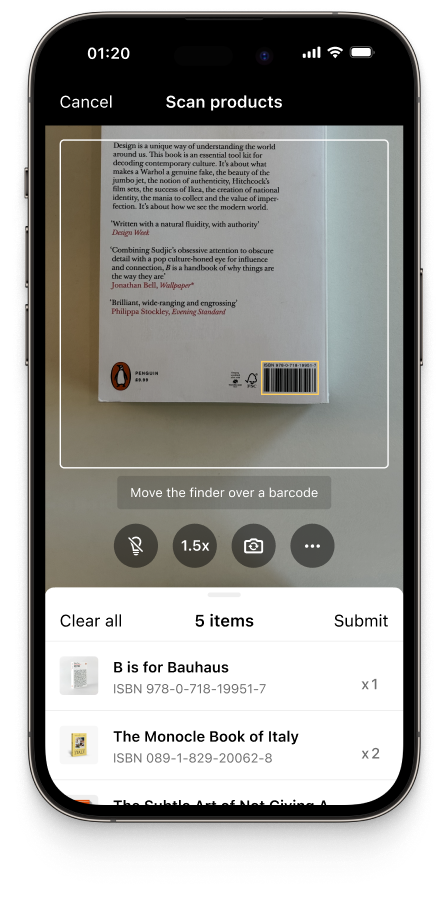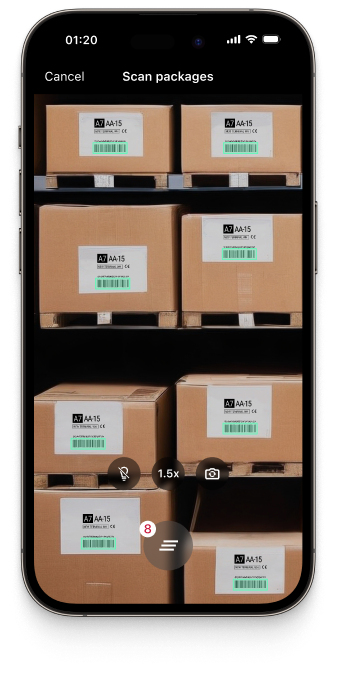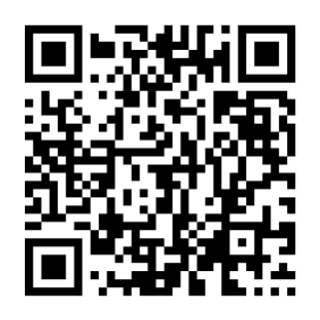Originally designed as manufacturing management tools, enterprise resource planning (ERP) systems are now comprehensive software platforms that businesses from all industries use to manage their core operations. They merge disparate functions into one common database, enhancing efficiency.
ERP systems began as form-fill systems, with their user interfaces designed for manual input. We have come a long way since: Modern mobile data capture technology enables ERP data entry by simply scanning barcodes with common smartphone applications.
Barcodes used in ERP system operations
An ERP system manages a wide range of core business operations on a single, integrated platform. In many of these areas, barcode technology can streamline workflows.
There is no one-size-fits-all barcode symbology, however: which barcode type is the best for a given application depends on operational requirements.
Generally, 1D barcodes are quick to read with ordinary laser scanners. However, they can’t encode as much information as their 2D cousins, which in turn require more capable scanners.
Let’s look at some key business operations that can be enhanced by barcode scanning, and the barcodes typically used for them:
| Business operation | Use case | Barcode types |
| Financial management | Encoding payment details and transaction IDs on invoices and receipts | 2D: Data Matrix, QR Code |
| Inventory and material management | Product labeling, stock tracking, warehouse bin locations, asset tracking, items with detailed attributes (batch numbers, expiry dates) | 1D: UPC, EAN, Code 128, Code 39 2D: QR Code and Data Matrix |
| Supply chain management | Cartons, pallets, and shipping containers for logistics, inbound/outbound tracking, automated order fulfillment, tracking and traceability | 1D: ITF-14, Code 128, GS1 DataBar |
| Manufacturing and production | Tracking of work orders, raw materials, components, and finished goods for traceability and quality control | 1D: Code 128 2D: Data Matrix, QR Code |
| Sales and order processing | Point-of-sale scanning, order picking and shipping | 1D: UPC, EAN, Code 128, GS1 DataBar 2D: QR Code |
If your business uses an ERP system to bring these operations together, it’s crucial to choose a barcode scanner solution that can scan all these barcodes – and any others that are relevant.
This demand for versatility is where mobile barcode scanners come into play.
Advantages of mobile barcode scanners over traditional devices in ERP systems
Traditional barcode scanners have shortcomings that mobile barcode scanners don’t. Above all, they are expensive, specialized hardware, and mobile technology is far more flexible.
Integrated into a web or mobile application, modern barcode scanner software turns common smart devices into fast and accurate barcode scanners.
Let’s now take a closer look at their numerous advantages over traditional scanner devices:
- Enhanced accuracy: Mobile barcode scanners are often more accurate than dedicated devices – thanks to advanced image processing capabilities. Furthermore, they can scan both 1D and 2D barcodes, unlike many traditional scanners, especially laser scanners.
- Familiarity and increased efficiency: Using smartphones as barcode scanners can speed up workflows because most employees are already familiar with them. This minimizes training time and motivates employees to use barcode scanning instead of slow, error-prone manual data entry.
- Flexibility and portability: Smartphones are lightweight and easy to carry. They are flexible, without restrictions like cords, and employees can use them anywhere and anytime – whether deep in a warehouse or on the road.
- Offline capabilities: Some mobile barcode scanning solutions function completely offline. Even without network connectivity, employees can keep working. The data synchronizes with the ERP system once connectivity is restored, minimizing interruptions.
- Real-time data access: Mobile barcode scanners enable real-time data input for ERP systems. Thanks to their ease of use and advanced barcode scanning capabilities, it is simple to add data capture to a range of processes. Like this, inventory level, stock movement, and order status data is always correct.
- Cost savings: Using smartphones instead of dedicated scanner devices reduces the long-term cost. Not only is the upfront cost often lower, smartphones can be used for other purposes, potentially replacing several expensive dedicated devices. Strategies like CYOD can unlock bulk discounts.
- Scalability: As soon as barcode scanning functionality is added to an app, it can be deployed on as many devices as needed. SaaS solutions with a fixed-price model are especially advantageous.
Overall, the benefits are substantial: Apart from their cost and scalability edge, mobile barcode scanners enhance decision-making by improving real-time data access and accuracy.
Integrate barcode scanning into your app with the Scanbot Barcode Scanner SDK
The Scanbot Barcode Scanner SDK offers a highly customizable user interface that can be easily adapted to your use case. Our Ready-to-Use UI components cover a wide range of barcode scanning scenarios and can be integrated into your web or mobile app within mere hours. If you want even more customization, our Classic UI components offer precisely that.
The SDK comes with a variety of features that are intended to streamline your workflows, most notably several scan modes:
- Batch Scanning: To scan a series of barcodes consecutively without closing the scanning screen.
- Multi Scanning: To capture multiple barcodes at once.
- Find & Pick: To scan and visually highlight only barcodes with certain values, simplifying finding the right product or package.
- Scan & Count: To count all barcodes in the viewfinder. The Scanbot SDK captures all barcodes at once and then instantly presents a list of the barcode values it detected, and how often.


With the Scanbot Barcode Scanner SDK, you can turn any smart device into a highly reliable and accurate barcode scanner. See for yourself how it performs by trying our free barcode scanner demo apps.
Or you can read more about exciting use cases, such as that of IMI – Agrippa, a Norwegian software solution provider for logistics, supply chain, and retail operations. Thanks to our versatile scan modes, IMI – Agrippa now offers its customers even better tools for optimizing every aspect of their business operations, from the warehouse to the retail floor.
Send us a message at sdk@scanbot.io if you have any questions or want to learn more about the SDK!
What is an ERP system?
An ERP (Enterprise Resource Planning) system is a centralized software platform that unifies a company’s essential business operations. Rather than using separate applications for accounting, inventory, sales, and human resources, an ERP connects all these functions into one central system where information is shared across the entire organization.
The primary advantages include:
– Streamlined communication between departments.
– Automated workflows that reduce manual tasks and errors.
– Real-time access to business data.
This unified approach improves operational efficiency and gives leadership valuable insights for better strategic decision-making.
What are the benefits of adding barcode scanning software to my ERP system?
Adding a barcode scanner to your ERP system reduces human errors by replacing manual data entry with direct scanning. This automation speeds up processes, saving you time and costs. Data is updated in real-time, enhancing data visibility and providing businesses with valuable insights for informed decision-making.
What should I consider when choosing barcode scanning software for my ERP system?
When selecting a barcode scanning software, consider the following factors:
– Compatibility: Make sure that the barcode scanner seamlessly integrates into your ERP system, and other business applications you currently use. Look for providers that offer solid documentation and reliable developer support to ensure smooth implementation.
– User experience: Choose a scanning solution with an intuitive interface that your team can learn quickly. Easy-to-use software reduces training time and encourages faster user adoption.
– Performance in real-life environments: A barcode scanner should be fast and able to read codes accurately in the first scan. Ensure that the scanner can handle challenging conditions like damaged, blurry, or tiny codes, as well as low lighting conditions. It’s recommended to thoroughly test the software in your specific work environment before making a final decision.
– Ease of integration and support: Evaluate how easy it is to implement the scanning software into your ERP system. Quick implementation leads to faster go-to-market. Additionally, choose a solution that’s well-maintained and receives regular updates supporting new platform versions and new devices.
– Scalability and pricing: Consider both upfront and ongoing costs when choosing a commercial scanning solution. A flat-rate licensing model provides cost predictability and makes it easier to scale your operations as your business grows.
Can the Scanbot Barcode Scanner SDK be integrated into my ERP system?
Yes, the Scanbot Barcode Scanner SDK can be customized to work with any ERP system. Our most common integrations are with SAP systems, with most customers using SAP HANA. The SDK’s flexible architecture also supports integration with other major ERP platforms like IBM and Oracle systems.







